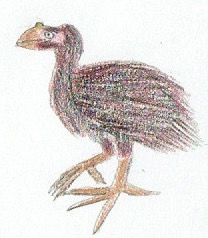A note on the writing style: Birds Of Sandy Island is written in a pretentious style with a lot of self-mockery. There are quite a few internal references that the reader is not always expected to "get". Also, extinct birds are frequently mentioned as if they are still with us. With that out of the way...
THE DWARF DU (Microsylviornis xenicus)
As many Pacific islands are inhabited by scrubfowl (Megapodius), so Sandy Island has a representative of this broad group. Sandy Island’s scrubfowl, however, is much more than a mere Megapodius; it is a member of that highly evolved offshoot of the tribe that contains Sylviornis, the giant Du of Grande Terre. With the discovery of Sandy Island’s dwarf Du, it is now obvious that size does not define Du-ality. The Dwarf Du is only about eight inches long, less than an eighth the size of Sylviornis. Its flightlessness makes it the only non-flying bird of its size that isn’t a crake or a grebe. Roughly scrubfowl-shaped but with a proportionally shorter, thicker neck, the Dwarf Du is feathered all over with fluffy rusty-blackish plumage, texturally similar to that of the Mauritius Red Rail. Like its giant cousin it has a thick rounded bill and a bony frontal casque; its eyes are surrounded with a patch of bare skin that can be distended in the male’s courtship display. In fact Wrye, the naturalist of the Warburton expedition that discovered Sandy Island, first considered classifying the breeding male as a separate species: the Wattle-eyed Du. Once he finally saw one at the point of beginning the courtship display, Wrye famously remarked, “Oh, Wattle-eyed Du now!”
Megapodes famously use heat to incubate their eggs, and the Dwarf Du is no exception. Like most megapodes, it buries its eggs in a mound of dead leaves. Though not quite the massive constructions of the Grande Terre Du, famously once believed to have been human burial mounds, formidable heaps are created by the Sandy Island species. Still, they are the smallest of all megapode mounds; in some places they appear as mere pimples—which would make adaptive sense if Sandy Island was volcanic (so they would get the rest of their heat from geothermal activity). Unfortunately, it isn’t. The Dwarf Du doesn’t seem to know that, though. Its small head, while not exceptionally small, is mostly jaw. More on that later.
Anyway, Dwarf Du differ from other megapodes in their habit of laying eggs in well-defined clutches within the mounds. Four is an average clutch size; the mound is only finished once the eggs are all laid, to ensure that the chicks hatch and emerge from the nest together. The interim period between egg laying and mound finishing, referred to by the islanders as “the bornge”, would be much more dangerous if Sandy Island had monitor lizards or snakes. As it is, it is still dangerous; eggs are predated by Robber Starlings and the occasional Great-billed Crake. Giant Pigeons do not take eggs, as the Dwarf Du coordinate their breeding with that of the pigeons so that there will be no Du eggs during the pigeons’ oophagous nonbreeding season.
Like other megapodes, the Dwarf Du is omnivorous. Insects and a variety of seeds are easily crushed in its proportionally heavy beak, but its preferred food is the seeds inside the fruits of the glasper vine. This strangler fig-like plant, which engulfs shrubs and small trees with a seeming lack of self-awareness, has very hard seeds which the Du’s jaws are adapted to crack. The Dwarf Du has a decidedly prehistoric facial appearance, with the large jaws taking up most of its flat head. Its call is usually a chicken-like “kek-kuk”, becoming an upslurred “krawk” when excited. The displaying male walks with a high step, shaking his head from side to side before stopping, head held high, and uttering an accelerating series of accented “keeark” notes. Young Dwarf Du begin displaying shortly after emerging from the mound.